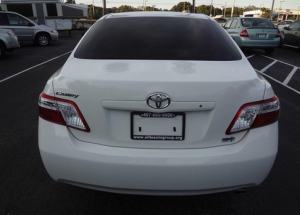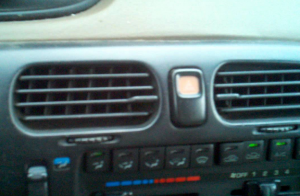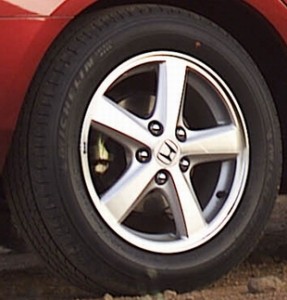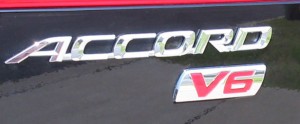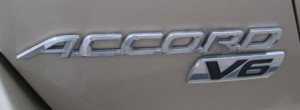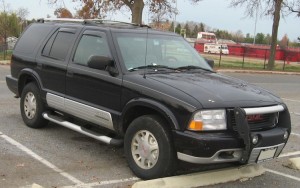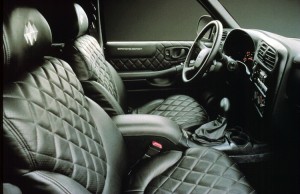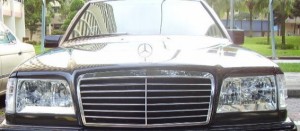2007-2009 Toyota Camry Tail Light Minutiae
Posted by Doug DeMuro in Minutiae of the Minute on | 8 comments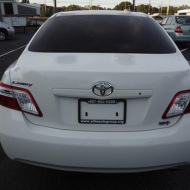
I haven’t done a good minutiae post in a while, which I believe we all can agree is a bad thing. And by “we all,” of course I mean me and the four or five people who care about this sort of thing.
Today’s topic is the tail lights on the 2007-2009 Toyota Camry. You know these tail lights well, because you’ve been stuck behind them, for hours on end, going the speed limit in the left lane of your major local interstate highways.
Toyota had three different powertrains for this Camry: a 2.4-liter 4-cylinder, a 268-hp V6, and a 4-cylinder hybrid. Interestingly, it also had two tail light designs.
The design above was used on all non-hybrid Camry models. Meanwhile, the design below was used on all hybrids.
Now, you might think these look pretty similar, and you’re right. But they have two crucial differences. One is obvious: the piece on the trunk is clear on the Camry Hybrid, while it’s half red on the gasoline-powered cars. Note to Camry Hybrid buyers: if your car has red trunk tail light pieces, it’s had bodywork.
The other difference is less obvious: while the Camry Hybrid has LED brake lights, the standard Camry does not. I have no possible explanation for why the did this, especially because the turn signals in both cars are non-LED.
Interestingly, most of these changes carried over when Toyota facelifted the Camry for the 2010 model year – but that’s a whoooole different article.
Mazda Oscillating “Swing Vents”: Minutiae of the Minute
Posted by Doug DeMuro in Minutiae of the Minute on | 13 comments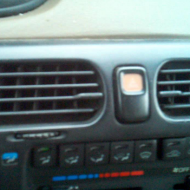
I think it’s time that we (and by we, of course I mean “I”) devote a second to Mazda’s swing vents, because it’s a topic that the mainstream automotive media, of which I am a part, are continually ignoring. This is almost certainly because no one cares.
But I care, and so does an alert reader who contacted me to tell me about the swing vents. But I already knew, as did four or five others out there, none of whom have a life either.
Here’s how it worked: you got in your early 1990s Mazda 626, put on the air conditioning or heat, and voila! The air pushed out of the vents as they moved back and forth. The result was your cabin was wafted with air, much like you’re royalty from thousands of years ago – you know, the ones that are always sitting in a throne-like chair while servants spread air back and forth using giant leaves.
I know this feature made it on the Mazda 626, and I think it was on the 929 as well. Supposedly, the first-generation Lexus LS400 also had it, though I’m unable to confirm that as first-gen LS400 owners are all currently asleep in their retirement communities. The LS430 may have also used it.
The Volkswagen Phaeton did not have oscillating vents, as many people think, but rather wood vent covers that electronically went up or down when you activated the climate control. If you have a Phaeton now, at least two of these probably still work.
Unfortunately, oscillating vents seemingly have gone the way of the carburetor – probably because they made absolutely no sense in the first place. Maybe Mazda could’ve made a competitive minivan if they hadn’t spent so much money on the damn oscillating vents.
(BONUS: this piece uses the word “oscillating” more times than anything else in Internet history. Just to be safe, oscillating oscillating oscillating.)
Here’s a video: http://www.youtube.com/watch?v=DWCxw7xKjko
Honda Accord V6 Manual Sedan Minutiae
Posted by Doug DeMuro in Minutiae of the Minute on | 27 comments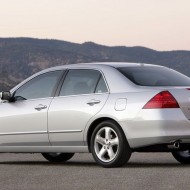
Let’s be honest: most of the Honda Accords out there are four-cylinder sedans with an automatic transmission. But you can, in theory, get a V6 Accord. And you used to be able to get a stick shift.
Of course, it’s no surprise a V6/stick combo was available in the “sporty” Accord coupe. But here’s an interesting fact: for two short years – 2006 and 2007 – you could also get an Accord sedan with a V6 and a stick shift. I consider this the high-water mark of the entire Accord run, although LaneWatch comes damn close.
Anyway: for those of you minutiae-obsessed enthusiasts out there, here’s an even cooler fact: you can tell apart the V6 manual sedans from the V6 automatics. Here’s how:
Wheels
The easiest way to tell the two cars apart is the wheels. Every single V6 manual Accord sedan used these:
This was very different from other Accord wheels. The closest wheel was this one, which was used in 2003 and 2004 on the four-cylinder Accord EX-L:
But if you ever get confused – or if the owner has changed the wheels, there’s always…
Badging
This is the best part about the V6 manual Accord sedan. On all the Accord V6 sedans with an automatic transmission, Honda included a boring ol’ badge that printed “V6” in black lettering. But the manual got it in red letters, like so:
Compared to the normal badge…
It’s hard to get any more minute than this. But remember: if you see an Accord V6 manual sedan, you’re looking at the rarest version of the ’03-’07 Accord in existence. That makes it interesting. To some of us.
GMC Jimmy Diamond Edition: Minutiae
Posted by Doug DeMuro in Minutiae of the Minute on | 14 comments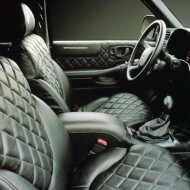
Ah, the Jimmy Diamond Edition. This one is worthy of a serious mention in the GM Bad Idea section, except for the fact that I have a confession to make: I actually like it. And by that, I mean I like it in a “Oh the Plymouth Prowler is cool, but I would never let my friends see me driving it” kind of way.
Let’s start with what the Jimmy Diamond is: ugly. But also a luxurious special edition version of the Jimmy sold late in its model run to try and earn a few sales from shoppers who thought the Oldsmobile Bravada was a little too retirement village.
There were a few major updates that distinguished the Jimmy Diamond from the standard Jimmy. The wheels were one. The chrome running boards were another. But most importantly, there was the odd strip of silver trim on both doors. All Jimmy Diamonds had that, while no regular Jimmys did (fortunately), so it’s a good way to distinguish between the two. Also: many, but not all, Jimmy Diamonds had a “grille guard” in front, for reasons totally unknown.
Now that we’ve covered the exterior, we must move on to the interior, which is the actual ugly part. That’s because the entire thing is covered with – truly – a diamond pattern. Diamond seats, diamond door panels, and – in case you forgot what you were sitting in – the Jimmy Diamond’s logo slapped on all four headrests. The logo was, of course, some diamonds.
Obviously, the Diamond Edition didn’t last long, and you rarely see them on the roads anymore. But if you ever visit the junkyard, at least you’ll know what you’re looking at. Then you’ll cover your eyes.
W124 Mercedes E-Class: Mirror Minutiae
Posted by Doug DeMuro in Minutiae of the Minute on | 17 comments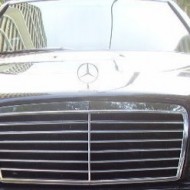
I once had a W124 500E. This was very impressive, but only to me and about three other people. Everyone else mainly said: Why the hell did you buy this crappy old Mercedes? This is especially true because I sold a 2001 E55 AMG to get it, and I actually paid more for the older, crappier Mercedes.
But there was one impressive detail about my W124. In fact, it was an impressive detail of all W124 models, which – by the way – is the chassis code for the E-Class made from 1985 to 1995. And that one impressive detail is the mirrors.
You see, all W124 models had two different mirror sizes. The driver side mirror was upright and narrow, while the passenger mirror was flat and wide. The theory was that W124 drivers would be in the left lane so often that they’d need a larger mirror to see right lane traffic. Obviously, the people who came up with this idea never drove a 200E.
Unfortunately, the advent of cost-cutting (which really had never before been undertaken at Mercedes-Benz) killed the dual-mirror setup when the W210 came out in 1996. And although I was happy to own both a W210 E-Class and its predecessor, the W211, nothing ever felt as stately as the 500E. Of course, my passengers would disagree.

